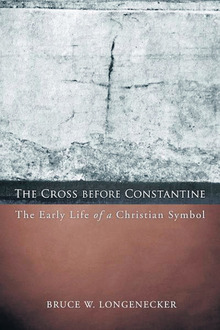The cross in your face
One visible difference between evangelical Protestants on the one hand, and Catholics and Eastern Orthodox on the other, is that the former, unlike the latter, do not make ‘the sign of the cross’ to ‘bless’ themselves, nor (generally) display a cross – and certainly not a crucifix displaying Christ in their worship, since the Bible is definite on the finished work of Christ upon the cross.
Dr Anthony McRoy

THE CROSS BEFORE CONSTANTINE:
The Early Life of a Christian Symbol
By Bruce W. Longenecker
Fortress Press. 244 pages £25.99
ISBN 978 1 451 490 305
Indeed, Protestants tend to see the use of ‘the sign of the cross’ either in worship or when something startling occurs, or in the face of malevolent supernatural power, as mere superstition, which should be avoided as idolatry. Often, it is held that the use of the cross as symbol in these ways is a product of the post-Constantinian era. Is this valid, and, right though we may be to avoid such superstitious acts as those previously listed, are we neglecting some of the deeper meanings of the cross?
In use as an early symbol
Longenecker, Professor of Early Christianity at Baylor University, Texas, has written an excellent book on the subject, which, unlike many academic works, is easy reading. It is also hugely informative. He is particularly at pains to demonstrate that the cross was used as symbol before Constantine. Usually it is claimed that the fish symbol was employed before then. Longenecker, however, shows that ‘Artifacts from the pre-Constantinian era demonstrate that the cross was occasionally featured within the symbolism of the first three centuries of Christianity – a fact that ultimately overturns both a consensus among certain sectors of the historical disciplines and a conviction held by certain religious groups today.’ (p.11).
He goes on to show various forms of the cross, such as the ‘T’ shape, the ‘body’ or Latin cross (with which most people are probably familiar), the equilateral cross, the ankh cross, the gamma cross ‘which looks like an upside-down L’ and the staurogram – the joint T and P (i.e. the Greek rho).
Wearing a cross
The book suggests that Christians began wearing the cross as a symbol earlier than the fourth century, e.g. Tertullian in the second century (Against Marcion 3.22) referring to the ‘sign upon the forehead’ (p. 9-30) which Longenecker interprets as the cross. Again, to Protestants, especially Nonconformists, this smacks of superstitious ritual. However, might the practice have derived from a visual ‘sermon illustration’ by Paul? Longenecker examines Galatians 3.1, and suggests that Paul physically enacted the crucifixion – ‘He must, at the very least, have held out his arms to dramatize a crucified body for his audience’ (p.41). A former youth evangelist in Britain used to do this. One can imagine that it would be an easy – though theologi-cally questionable – step from physically reenacting the crucifixion to displaying some form of symbol of that act.
First-century coffins
The Cross before Constantine then examines Jewish ossuaries, including those from the first century, and some of these have crosses marked on them. Longenecker sees the origin of this in Ezekiel 9.4-6, which commands that ‘a mark’ be placed on the foreheads of those who weep for the abominations practised in Jerusalem (p.55). The Hebrew word for ‘mark’ is tav, which could be represented by either + or x. This mark ‘morphed to become a transferable mark of protection’ (p.56), that is, by Yahweh.
This mark in Ezekiel came to be interpreted by Christian theologians in the first three centuries (i.e. before Constantine) as the cross of Jesus (p.58). He also sees this taken up in Revelation 7.3 (p.64).
Barnabas?
Of course, exegetically speaking, this is delicate ground at best, but the so-called Epistle of Barnabas (c.90s-132) seems to make use of the general idea, in chapter 12, where, recalling Exodus 17.9-14, Moses, in the battle against Amalek, is instructed ‘That he should make a figure of the cross [tupon staurou] and of him [i.e. Jesus] about to suffer thereon’ (p.62). Thus, Moses demonstrably ‘formed the shape of a cross’ which gave Israel victory. Surprisingly, Longenecker does not connect Exodus 17.12 in the Septuagint with John 19.18 where the same phrase in Greek enteuthen kai enteuthen – ‘one on either side’ is used. Longenecker refers to this as the ‘apotropaic function’ of the cross – warding off evil.
Superstition
Naturally, we can see how this degenerated into superstition, with the cross symbol being seen as a bane against the occult, such as witches or so-called vampires (which, one fears, is how many if not most of the younger generations today see it because of the success of vampire-themed TV shows and movies). However, leaving aside the actual symbol of the cross, its continuing dynamic spiritual character is sometimes neglected by Evangelicals. At times, Christians face particular attacks from the devil – occasionally in the form of acute depression which is not linked to some event or illness. A.W. Pink once referred to some people who were ‘the helpless doormats of Satan’, not knowing how to resist him – and then commented that Revelation 12.11 ‘tells us how!’ – by the blood of the Lamb, shed on the cross. In some situations demonic oppression is real, perhaps because of occult activity, and here the dynamic character of the cross as victory over the demonic realm is applicable – after all, Jesus said of his upcoming crucifixion: ‘now is the prince of this world cast out’ (John 12.31). Perhaps evangelicals, who tend to focus quite rightly on the cross as rendering penal satisfaction, need to be reminded of this. Of course, one can do this spiritually without any unnecessary symbolism, such as wearing a cross.
In the British Museum
Longeneker then goes on to give examples of depictions of crosses, such as in a Roman sepulchre dated to 282 (p.76); in the Lucina catacomb, whose cross is dated to the late second or early thirds century (p.82); the Priscilla catacomb dated to the second half of the second century (p.83); a third century ring from Ostia with the word ichthys in the shape of a cross, and various rings from the same century with some form of cross or staurogram on them.
There is even a bloodstone gem from Gaza in the British Museum which had an ‘apotropaic function’ depicting a crucified Jesus, dated to the late second or early third century (p.103). Christian papyri from the same era (P46, P66, P75) also employ the staurogram, which provides ‘a graphic depiction of Jesus crucified on the cross’, (p.106). In P66 there are ‘five occurrences of the staurogram within the Greek of John 19:15-20’, and in each case the Greek noun stauros or a form of staurein (‘crucify’) ‘is written without the intervening vowels au and with the letter rho ‘superimposed on top of the letter tau to form the shape of a crucified person – Jesus’ (p.107).
Talking to Muslims
There are various other examples, but it can be seen that long before the reign of Constantine, Christians were depicting the cross in some ways. Apart from the spiritual significance of the cross of which the theme of this book should remind us (as opposed to actually employing the symbolism), Longenecker’s history of cross depictions is also helpful in contemporary apologetics and evangelism. Usually the second statement that a Muslim will make to a Christian, after claiming that the Bible was changed, is a denial that Jesus was crucified. Normally, this involves the idea that someone else – whose features were changed – was crucified in his place while Jesus was rapt to Paradise. Often they will say it was Judas (the Shia Hadith implies this). Frequently, Muslim apologists will claim that ‘some early Christians also believed something like this’, but they never give dates and they fail to state that they are referring the Gnostic followers of Basilides, who made such claims about a century after the crucifixion!
The Ahmadiyya sect, regarded as deviant by mainstream Muslims, holds that Jesus swooned and was revived and this idea has begun to win support among many Sunnis. Thus, before we can press the spiritual significance of the crucifixion, we must establish its historicity. This is what this book helps us to do. Longenecker notes that other Gnostics, as in the Book of Jeu, ‘went a different route, giving the cross meaning within a Gnostic frame of reference’ (p.99). This reinforces the early Christian, Jewish and pagan written records of the crucifixion of Jesus, up to Basilides.
Definitely crucified
Also, the infamous early third century Alexamenos inscription from Rome, depicting Christians worshipping a donkey-headed man, shows that non-Christians were acutely aware that Christians worshipped the crucified Christ (pp,74-76). The geographical spread of the data from Syria through Asia Minor and Egypt to Rome, and its temporal spread from the first and second centuries onwards (chapter 8) demonstrates that the early Christians – and their opponents - were convinced that Jesus was indeed crucified. That is objective, empirical history; to declare that he was crucified for our sins is our spiritual mission.

